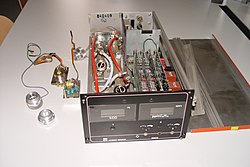Nondispersive infrared sensor
A nondispersive infrared sensor (or NDIR sensor) is a simple

Principle
The main components of an NDIR sensor are an infrared (IR) source (lamp), a sample chamber or light tube, a light filter and an infrared detector. The IR light is directed through the sample chamber towards the detector. In parallel there is another chamber with an enclosed reference gas, typically nitrogen. The gas in the sample chamber causes absorption of specific wavelengths according to the Beer–Lambert law, and the attenuation of these wavelengths is measured by the detector to determine the gas concentration. The detector has an optical filter in front of it that eliminates all light except the wavelength that the selected gas molecules can absorb.
Ideally other gas molecules do not absorb light at this wavelength, and do not affect the amount of light reaching the detector however some cross-sensitivity is inevitable.
The IR signal from the source is usually chopped or modulated so that thermal background signals can be offset from the desired signal.[3]
NDIR sensors for carbon dioxide are often encountered in heating, ventilation, and air conditioning (HVAC) units.
Configurations with multiple filters, either on individual sensors or on a rotating wheel, allow simultaneous measurement at several chosen wavelengths.
Research
Miniature IR sources based on
Gases and their sensing wavelengths

Gases do not have a specific sensing wavelength, rather there are regions of the IR spectrum where there are typically many thousands of closely spaced absorption lines. See the Hitran database for more information.
- O2 - 0.763 μm[6]
- CO2 - 4.26 μm,[7] 2.7 μm, about 13 μm[6]
- CO - 4.67 μm,[7] 1.55 μm, 2.33 μm, 4.6 μm, 4.8 μm, 5.9 μm[6]
- NO2 - 6.17-6.43 μm, 15.4-16.3 μm, 496 nm[6]
- N2O - 7.73 μm (NO2 and SO2 interfere),[9][7] 1.52 μm, 4.3 μm, 4.4 μm, about 8 μm[6]
- HNO3 - 5.81 μm[6]
- NH3 - 2.25 μm, 3.03 μm, 5.7 μm[6]
- H2S - 1.57 μm, 3.72 μm, 3.83 μm[6]
- SO2 - 7.35 μm, 19.25 μm[6]
- HF - 1.27 μm, 1.33 μm[6]
- HCl - 3.4 μm[6]
- HBr - 1.34 μm, 3.77 μm[6]
- HI - 4.39 μm[6]
- hydrocarbons - 3.3-3.5 μm, the C-H bond vibration[7]
- CH4 - 3.33 μm, 7.91±0.16 μm can also be used,[10] 1.3 μm, 1.65 μm, 2.3 μm, 3.2-3.5 μm, about 7.7 μm[6]
- C2H2 - 3.07 μm[6]
- C3H8 - 1.68 μm, 3.3 μm[6]
- CH3Cl - 3.29 μm[6]
- H2O - 1.94 μm, 2.9 μm (CO2 interferes),[7] 5.78±0.18 μm can also be used to avoid interference from CO2,[10] 1.3 μm, 1.4 μm, 1.8 μm[6]
- O3 - 9.0 μm,[7] also 254 nm (UV)[6]
- H2O2 - 7.79 μm[6]
- alcohol mixtures - 9.5±0.45 μm[10]
- HCHO - 3.6 μm[6]
- HCOOH - 8.98 μm[6]
- COS - 4.87 μm[6]
Applications
References
- ^ "NDIR Gas Sensor Light Sources". International Light Technologies. Archived from the original on 5 December 2012. Retrieved 9 May 2016.
- ^ Title 40: Protection of Environment, Part 1065—Engine-Testing Procedures, Subpart D—Calibrations and Verifications, §1065.350 H2O interference verification for CO2 NDIR analyzers
- ^ Seitz, Jason; Tong, Chenan (May 2013). SNAA207 – LMP91051 NDIR CO2 Gas Detection System (PDF). Texas Instruments.
- .
- ^ PMID 31060244.
- ^ ISBN 9781461471653. Retrieved 16 April 2018 – via Google Books.
- ^ a b c d e f Technologies, Jason Palidwar, Iridian Spectral. "Optical Filters Open Up New Uses for MWIR, LWIR Systems". photonics.com. Retrieved 16 April 2018.
{{cite web}}: CS1 maint: multiple names: authors list (link) - ^ "Archived copy". Archived from the original on 2017-09-16. Retrieved 2020-01-16.
{{cite web}}: CS1 maint: archived copy as title (link) - S2CID 56277453.
- ^ a b c "Archived copy" (PDF). Archived from the original (PDF) on 2018-02-24. Retrieved 2020-01-16.
{{cite web}}: CS1 maint: archived copy as title (link)
External links
- NDIR & CO2 Sensors Explained, The Gas Detector Encyclopedia, Edaphic Scientific Knowledge Base
- NDIR Gas Sensor Lamp Selection Application Notes
- NDIR Technology for gasoline exhaust Archived 2014-10-17 at the Wayback Machine
- NDIR detectors for CO&CO2 in internal combustion engine exhaust
